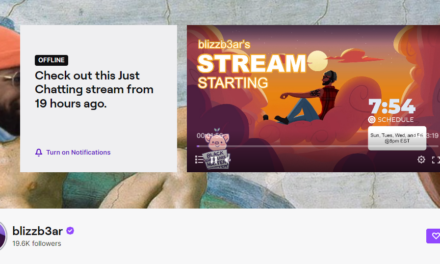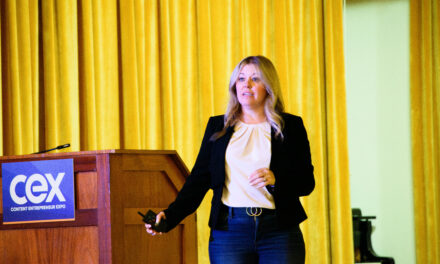
SEPTEMBER 17, 2021
full tilt
Affiliate Marketing Brings Big Revenue to Content Creators Who Build Big Audiences
“Make money while you sleep.”
It sounds like a too-good-to-be-true scam. But content entrepreneurs frequently use passive income streams in their business.
One of the most popular is affiliate marketing. A third party pays a commission to a creator or influencer any time a shopper uses their unique link to purchase products or services from that company.
Affiliate marketing isn’t new. In 1994, Zac Johnson participated in the BuyWeb program created by CDNow, a company that sold CDs and tapes. In the nascent days of the public internet, other site creators could include a referral link to CDNow and earn money every time someone used it to buy a CD or tape and have it shipped to them.
Affiliate marketing has come a long way. Today, over 80% of brands have some type of affiliate marketing program. It’s a great way for them to reach established audiences through someone those readers, viewers, or listeners trust. By 2022, the industry is expected to spend $8B on affiliate marketing.
Audience-focused content creators are key players in that market. For example, a blogger can post about the best travel essentials and link their recommendations to the brand’s commerce page. Likewise, a beauty-focused Instagrammer could ask viewers to swipe up to see an affiliate marketing link to related industry products. (Disclosure of the relationship is a must to keep audience trust.) In return, the blogger earns a percentage of what their reader spends.
Affiliate marketing often is one of the top revenue streams for content entrepreneurs. PayScale reports the average affiliate marketing annual income is $51K, with the bottom 10% earning $37K and the top bringing in $71K.
Tilt Advice
Yes, you can make money while you sleep. But that doesn’t mean you can sleep on the job. It takes hard work to build and grow an audience that will attract brand interest. And you can’t stop; you have to strategically plan how to incorporate those affiliate links into your content business.
To participate in affiliate programs, you need to apply. In umbrella-organized affiliate programs, you also may need to apply to the individual brands within the program. The application forms typically ask about your site, audience size, unique visitors, and total views per month. Most programs have minimum thresholds for audience or views before they accept the creator.
Once you get approved, you can use their affiliate links and start earning commissions. If you get rejected, you can always ramp up your blog and social platforms and reapply.
Here are a few of the most popular programs:
- Rakuten Advertising: They represent over 1K brands, including Sephora, New Balance, Pac Sun, and Ray-Ban. They also use commission suite software to help creators decide how they’re going to implement their program and receive proper credit for their contribution to a purchasing decision.
- LIKEtoKNOW.it (owned by Rewardstyle): LTK focuses on social media followings. Its affiliate partners create personalized shops with access to over 5K brands. The program includes retargeting reminders and one-on-one growth consulting. You’ll need about 10K page views per month or about 10K Instagram followers.
- Amazon Associates: Connect your content brand with the world’s largest online marketplace through this program. This program is designed for content creators who operate on their own, such as bloggers and podcasters. You can earn from $100 to $25,000 per month from an Amazon affiliate website, depending on your site traffic and conversions. However, please note that Amazon recently slashed its commission rates.
- Amazon Influencers: Designed for social media influencers, this program lets you set up a shop with a dedicated link as you promote and recommend products on your social channels.
It isn’t easy, but if you work hard to build, grow, and engage your audience, affiliate marketing could become a great revenue stream for your business. And that will help you sleep easier at night (while you make money too).
– Bonnie Azoulay
To learn how one blogger does affiliate marketing and how much it brings in, read the longer story.
Self-Described Gay, Black Martha Stewart Finds Big Business in GIFs
Entrepreneur and Biz: Robert Blackmon
Tilt: Self-described gay, Black Martha Stewart
Primary Channel: Giphy (1.4K GIFs; 7.9B views)
Other Channels: TikTok (1.4M), Instagram (23.1K), Twitter (22.2K), Facebook (18K), YouTube (1K)
Rev Streams: GIF licensing, sponsorships, book sales, speaking engagements, merchandise, YouTube, TikTok
Our Favorite Actionable Advice:
- Find a fresh format: GIFs aren’t a new format, but it’s a fresh twist to turn it into the largest revenue stream for a content business. You don’t always have to follow mainstream practices.
- Get expert input: Robert relied on the advice of his marketing and social media manager for her opinion about GIF creation.
- Stay connected: You’ll likely come across similar needs as you grow your business. It makes sense to stay in touch with partners who have provided quality services.
Some of the Story
Over two decades ago, Robert Blackmon quit his full-time job and turned himself into a brand — the gay, Black Martha Stewart as he calls himself today.
He offers expert advice on everything from fashion to health, fitness, home, food, entertainment, and how-tos for living your best life. But his GIFs are what has set him apart as a content entrepreneur.
He’s created over 1.4K of those short, soundless pieces of animated content that have been viewed more than 7.7B times. Robert says he has one for every occasion and creates new ones each week. He attributes a large part of his income to his GIFs through licensing, sponsorships, and contracted requests.
While Robert may come across as a self-made man, he has staff support. In fact, the mastermind behind launching his GIF business was his head of marketing and social media manager.
“Amanda (Cee) started all of these shenanigans about six years ago. I completely hold her responsible because she is my mentor. I was looking for someone to manage my direction. I didn’t think that I could afford her because I was really not even a mom and pop. I was just the pop at the time. But a friend of mine had worked with her and said, ‘I have somebody, and she’s the best. But she’s not cheap,’” Robert remembers.
It turns out that the partnership with Amanda has been the best thing for Robert. “I don’t believe that you need to spend necessarily a lot of money to impress people but do spend money where you can wisely allocate it,” he says. “She’s been the best money ever spent because what she’s done for me is she has opened my eyes to what’s possible.
“I didn’t even know the things that I can now do were possible if it weren’t for her. She pushes me in directions where she knows my talents are, but she also was that kind of person that says, ‘Don’t waste your time with that because it’s not worth your time.’”
– Kimmy Gustafson
All the Story: To learn Robert’s advice for content entrepreneurs, check out the longer story.
tilt shout-out
Shout out to PrimoStats!
Are you tired of grabbing outdated statistics from roundup posts? PrimoStats is a searchable database of curated marketing stats. This easy-to-use tool helps marketers and writers add credibility to their content — without wasting hours on Google.
Get the latest stats and save time. Try PrimoStats for free.
quick talk
Caught on … Twitter
“If content ‘going viral’ is your overall goal, you’re doing content wrong.”
– James Tennant
things to know
Money
-
Business acceleration: LinkedIn is investing $25M in its new Creator Accelerator Program. Up to 100 creators will join the 10-week, incubator-style program. It includes coaching, promotion on LinkedIn channels, and a $15K grant. (LinkedIn)
Tilt Take: If your target audience is business professionals, this could be a good kick-start for your content business. -
Repeat after me: To monetize a blog, it needs to have great content, be focused on one or two topics, and be published consistently. (Blogging Guide)
Tilt Take: It’s a recent article, but its advice is timeless (and what we wholeheartedly endorse).
Audiences
-
Great gorilla: Intuit’s $12B deal for Mailchimp is a data play (among other things). “There is incredible power in combining the customer data and the purchase data, and we wanted to put the power of the data in our customers’ hands,” Intuit’s CEO said. (Reuters)
Tilt Take: That’s a resounding vote for the power of your audience’s data. Your audience data strategy can be a valuable asset that attracts brands to work with you (and maybe even buy your business someday). -
Community-minded: Don’t think of your business interactions as transactional. Build a community. Take time each day to respond on social, reply to emails, and listen to your audience. (Forbes)
Tilt Take: More and more, we advocate seeing your audience as a community. That perspective can change your thinking and your business.
Tech and Tools
-
Passage perk: Search results now highlight passages of content that deliver the answer instead of linking to a page and forcing the searcher to figure out where it is. Google’s John Mueller says crawlers now can ignore weakly relevant sections while finding a super relevant section, highlighting that, and elevating the page’s ranking. (Search Engine Roundtable; h/t tl;dr marketing)
Tilt Take: Good news for long-form content creators relying on SEO. You don’t have to play the short game for SEO. Now, your content can get discovered even if it’s later in the content or not addressed in the meta description. -
Go long: LinkedIn Page owners now can do long-form content too. The social media platform launched Articles for Pages, which now allows companies to publish blog-style content of any length. (SearchEngine Journal)
Tilt Take: Now that long-form content isn’t reserved for individual accounts, content creators targeting the professional community would do well to have a LinkedIn Page for their content business.
And Finally
-
Responsible drinking promotion: More agencies are pledging to follow global standards when they work with influencers to promote alcohol-related products, including more responsible depictions of drinking. (Publishers’ Daily)
Tilt Take: We’re glad to see this. Encouraging irresponsible or reckless behavior (see TikTok milk-crate challenge) is not helpful to influencers, their audiences, or brands in the long term. -
Ethics on social: A Wall Street Journal report revealed Facebook knows Instagram is toxic for teen girls. That prompted Scott Monty to talk about the ethics challenge: “If you’re pursuing profits at the expense of your values or the values of a decent society, it’s all just smoke and mirrors.” (Timeless & Timely)
Tilt Take: Don’t wait for an ethical challenge to present itself to you. Decide now what you will or will not do in your content creation. Write down those guidelines, share them with your audience, and follow them.
we’re a stan for Baddie Winkle
Helen Van Winkle, aka Baddie Winkle, found her way onto her 3.4M Instagram feeds after posting a photo of herself in a brightly colored Grateful Dead T-shirt and matching socks decorated with pink marijuana leaves.
In an interview with Money CNN, the 93-year-old said her great-granddaughter “would come home from school every day, and she would say, ‘Gram, come look, you’re up 20,000 today.’ I mean, it just kept going.”
She became a fashionista. As she told Repeller, “I got to be an Instagram whatever-I-am. I did start wearing different clothes, younger clothes. And it was so much fun that I started wearing them all the time.”
After gaining popularity online, she’s traveled for appearances at events in Los Angeles, Las Vegas, and New York and connected with other well-known fashion and lifestyle influencers. This year, she even made Insider’s list of 13 Inspiring Influencers Over 60 You Should Be Following. As of six years ago, Winkle was making up to $5K for every sponsored post.
Why we’re a Stan: Helen didn’t let age get in the way of her expressing her style online. As she gained popularity, she doubled down on the fun fashion and turned into a content entrepreneur.
– Shameyka McCalman
the business of content
In this week’s Content Inc. podcast, Joe discusses if a new business model for content entrepreneurs is upon us. Well … maybe. It’s possible that new community-first models are superior to Web 2.0 models of the past.
In the latest This Old Marketing podcast episode, Joe and Robert talk about the audience land rush, with Intuit leading the way. Oh … and more about NFTs, the good and the bad.
the tilt team
Your team for this issue: Joe Pulizzi, Ann Gynn, Laura Kozak, Marc Maxhimer, and Dave Anthony, with an assist from Bonnie Azoulay, Kimmy Gustafson, Shameyka McCalman, and Don Borger.
Get more of the Full Tilt stories on TheTilt.com.
Know a content creator who’s going full tilt? DM us or email [email protected]
Was this email forwarded to you? Get your own sub here.
Copyright ©2021 Tilt Media LLC All rights reserved.
Unsubscribe | Update your profile | 17040 Amber Drive, Cleveland, OH 44111





